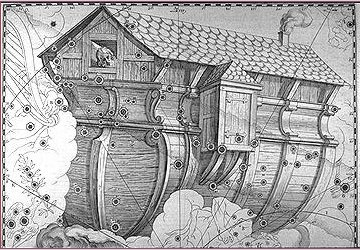384. There seems to have
been a key for unlocking all the secrets in form of 3 extra days:
|
MARCH 18 |
19 |
20 (*364) |
 |
 |
 |
|
Gb8-28 (240) |
Gb8-29 |
Gb8-30 (☼59) |
|
*61 |
*62 |
*63 |
|
3 |
|
... Väinämöinen
set about building a boat, but when it came to the prow and
the stern, he found he needed three words in his rune that
he did not know, however he sought for them. In vain he
looked on the heads of the swallows, on the necks of the
swans, on the backs of the geese, under the tongues of the
reindeer. He found a number of words, but not those he
needed. Then he thought of seeking them in the realm of
Death, Tuonela, but in vain. He escaped back to the world of
the living only thanks to his potent magic. He was still
missing his three runes. He was then told by a shepherd to
search in the mouth of Antero Vipunen, the giant ogre. The
road, he was told, went over swords and sharpened axes.
Ilmarinen made shoes, shirt and gloves of iron for him, but
warned him that he would find the great Vipunen dead.
Nevertheless, the hero went. The giant lay underground, and
trees grew over his head. Väinämöinen
found
his way to the giant's mouth, and planted his iron staff in
it. The giant awoke and suddenly opened his huge mouth.
Väinämöinen slipped into it and was swallowed. As soon as he
reached the enormous stomach, he thought of getting out. He
built himself a raft [cfr The Heavenly Raft,
θ Aquilae, *305], and floated on it up and down inside
the giant.
The giant felt
tickled and told him in many and no uncertain words where he
might go, but he did not yield any runes. Then Väinämöinen
built a smithy and began to hammer his iron on an anvil,
torturing the entrails of Vipunen, who howled out magic
songs to curse him away. But Väinämöinen said, thank you, he
was very comfortable and would not go unless he got the
secret words. Then Vipunen at last unlocked the treasure of
his powerful runes. Many days and nights he sang, and the
sun and the moon and the waves of the sea and the waterfalls
stood still to hear him. Väinämöinen treasured them all and
finally agreed to come out. Vipunen opened his great jaws,
and the hero issued forth to go and build his boat at last
...

|
Hamal (*30) was the 1st of the leaders, but a
great change up in the sky came when the Sun reached
Alcyone 30 days later (*56 = ☼52).
In a way, therefore, Hamal was not up on dry land (terra firrma)
but still down in the water.
... At the time of
the loading of the emigrant canoe, Hotu Matua ordered his
assistant Teke to take a (stone) figure (moai)
named Oto Uta on board the canoe, along with the people (aniva)
who were emigrating. However, the figure was 'left behind out in
the bay' (E:73 → MARCH
14).
|
Manuscript E page 1: |
|
ko oto uta |
ariki motongi |
1 |
|
ko tangaroa.a oto uta |
ariki motongi |
2 |
|
ko tiki hati.a tangaroa |
ariki motongi |
3 |
|
ko roroi.a tiki hati |
ariki motongi |
4 |
|
ko tuu kumā.a roroi |
ariki motongi |
5 |
|
ko ataranga.a tuu kumā |
ariki motongi |
6 |
|
ko harai.a ataranga |
ariki motongi |
7 |
|
ko taana.a harai |
ariki motongi |
8 |
|
ko matua.a taana |
ariki motongi |
9 |
|
ko hotu.a matua |
ariki motongi |
10 |
|
O maori te ariki nei.
etahi te angahuru. ko maori. te ingoa o te kainga.
ko marae renga te ingoa. o te maara noho o te
ariki.nui.ko ma rae tohia te rua maara noho o te
ariki. |
|
Sumerian W-B. 144 |
|
1 Alulim |
28,800 |
|
2 Alagar |
36,000 |
|
3 Enmenluanna |
43,200 |
|
4 Eumengalanna |
28,800 |
|
5 Divine Dumuzi |
36,000 |
|
6 Ensibzianna |
28,800 |
|
7 Enmenduranna |
21,000 |
|
8 Ubardudu |
18,600 |
|
9 |
- |
|
10 |
- |
|
Sum |
241,200 |
|
|
Sumerian W-B. 62 |
|
1 Alulim |
67,200 |
|
2 Alagar |
72,000 |
|
3 Kidunnushakinkin |
72,000 |
|
4 ... ? |
21,600 |
|
5. Divine Dumuzi |
28,800 |
|
6 Enmenluanna |
21,600 |
|
7 Enzibzianna |
36,000 |
|
8 Eumenduranna |
72,000 |
|
9 Arad-gin |
28,800* |
|
10 Ziusudra |
36,000 |
|
Sum |
456,000 |
|
|
Berossos |
|
1 Aloros |
36,000 |
|
2 Alaparos |
10,800 |
|
3 Amelon |
46,800 |
|
4 Ammenon |
43,200 |
|
5 Megalaros |
64,800 |
|
6 Daonos |
36,000 |
|
7 Euedoraches |
64,800 |
|
8 Amempsinos |
36,000 |
|
9 Opartes |
28,800 |
|
10 Xisuthros |
64,800 |
|
Sum |
432,000 |
|
|
The Bible (King James' verison) |
|
1 Adam |
130 |
|
2 Seth |
105 |
|
3 Enoch |
90 |
|
4 Kenan |
70 |
|
5 Mahalel |
65 |
|
6 Jared |
162 |
|
7 Enoch |
65 |
|
8 Methuselah |
187 |
|
9 Lamech |
182 |
|
10 Noah: until Flood |
600 |
|
Sum |
1,656 |
|
|
*
Campbell has 28,000 here, which, however, does
not agree with the sum 456,000. |

|






